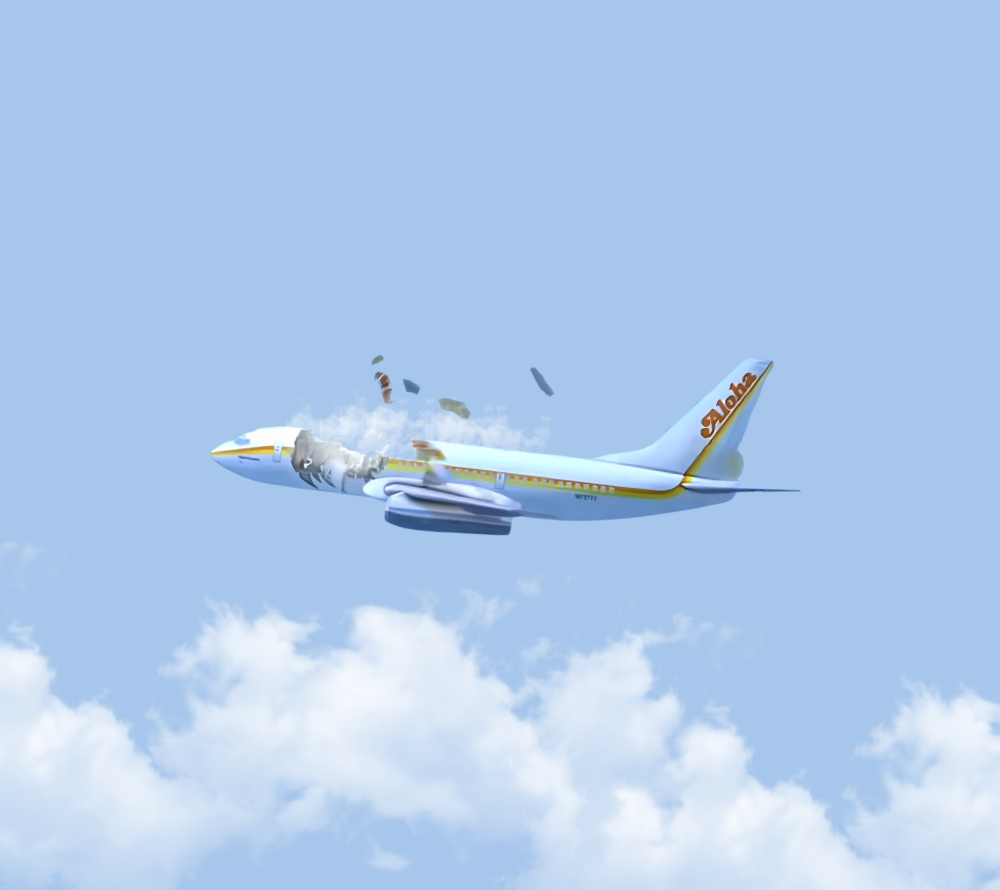Introduction
On April 28, 1988, Aloha Airlines Flight 243, a Boeing 737-200, was on a routine inter-island flight from Hilo to Honolulu. Just 23 minutes after takeoff, at 24,000 feet, a large section of the fuselage roof suddenly tore away. The explosive decompression ripped open the cabin, exposing passengers to the sky and hurricane-force winds.
Despite the chaos, the pilots managed to keep the crippled plane airborne and divert to Kahului Airport on Maui. Astonishingly, the aircraft landed safely with 94 passengers and crew surviving. Tragically, flight attendant Clarabelle “C.B.” Lansing was swept from the cabin during the decompression and lost her life.
The event became one of aviation’s most famous cases of “structural failure in flight” and highlighted the dangers of aging aircraft operating in harsh conditions.
What Went Wrong
1. Aging aircraft and high cycles
The Boeing 737-200 had flown since 1969 and logged over 89,000 flight cycles, far beyond typical usage. Its constant short flights between Hawaiian islands exposed it to frequent pressurization and depressurization, accelerating structural fatigue.
2. Metal fatigue and corrosion
Microscopic cracks had formed in the fuselage lap joints over years of service. The salty, humid Hawaiian climate further corroded the aluminum structure. The cracks spread until the skin failed catastrophically on Flight 243.
3. Undetected damage
Maintenance inspections missed the signs of fatigue and corrosion. At the time, visual checks were the main method, and inspectors did not detect the cracks hidden beneath paint and sealant. Non-destructive testing methods were not widely used.
4. Explosive decompression
When the fuselage tore open, the sudden loss of pressure ripped a section of the cabin roof away. Passengers were exposed to open air, but seatbelts prevented more from being ejected. The crew had to fight to control the violently shaking aircraft.
Consequences
• Flight attendant Clarabelle Lansing was killed instantly, the only fatality among 95 people on board.
• 65 passengers and crew sustained injuries ranging from lacerations to head trauma caused by flying debris and wind blast.
• The pilots, Captain Robert Schornstheimer and First Officer Madeline Tompkins, were praised for their calm skill under extreme circumstances. Their safe landing on Maui became a textbook example of professionalism and teamwork.
• Images of the gaping hole in the fuselage shocked the world and raised urgent questions about aircraft safety.
The disaster led to major changes in aviation safety:
• Aging aircraft inspections: The FAA launched the “National Aging Aircraft Program,” requiring airlines to perform more thorough and frequent structural checks, especially on high-cycle planes.
• Non-destructive testing: Airlines adopted advanced tools like ultrasonic and eddy-current scanning to detect hidden cracks invisible to the naked eye.
• Redesign of lap joints: Boeing and other manufacturers redesigned fuselage joints to prevent similar failures.
• Environmental awareness: Operators began paying closer attention to how humidity, salt, and temperature cycles affect aircraft structure.
• Crew training focus: The successful handling of Flight 243 reinforced the importance of cockpit resource management and calm decision-making in crises.
Conclusion
Aloha Airlines Flight 243 stands out as both a tragedy and a miracle. The violent loss of a section of fuselage at cruising altitude could easily have caused mass fatalities, yet the crew’s skill saved nearly everyone on board.
The accident highlighted the hidden risks of flying older, heavily used aircraft in harsh environments. It forever changed how airlines maintain and inspect their fleets. Today, the lessons of Flight 243 live on through stricter maintenance programs, advanced inspection technology, and a greater commitment to passenger safety.
